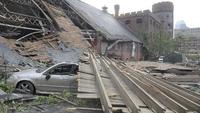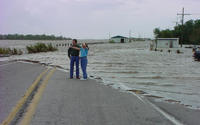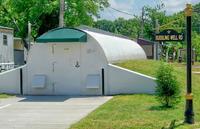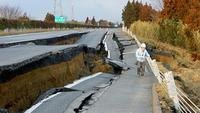-
Iran pushes ahead with nuke plans, despite seismic warnings
Iranian officials have chosen to ignore the warnings of top scientists and continue with the construction of nuclear facilities near earthquake prone regions; according to an official with the International Atomic Energy Agency, in a top level meeting Iran’s leaders recently decided to move ahead with plans to construct nuclear facilities, despite Iranian scientists’ warnings that “data collected since the year 2000 shows the incontrovertible risks of establishing nuclear sites in the proximity of fault lines’ in Khuzestan as well as nineteen other Iranian provinces; Iran is one of the most seismically active countries in the world with major fault lines covering at least 90 percent of it
-
-
Climate change and cities: a wake-up call

More than half the world’s population live in cities, many of which are increasingly vulnerable to the impacts of climate change; cities, however, are also emerging as the innovative “first responders” in dealing with climate change; climate change will stress cities in many ways — there will be more heat waves, threatening the health of the elderly and infirm; droughts will also become more commonplace in many cities, while in coastal communities too much water may be the problem, due to sea-level rise and more extreme coastal flooding
-
-
Deadly tornado kills four in Massachusetts

On Wednesday, as many as seven tornadoes tore through Massachusetts resulting in the state’s first twister related deaths in sixteen years; the tornadoes touched down in the western and central part of the state, but hit Springfield, located ninety miles west of Boston, the hardest; more than forty people have been admitted to hospitals after sustaining injuries from the tornado and four people have been confirmed dead so far; emergency responders are currently picking through the wreckage to rescue any survivors trapped in the rubble
-
-
Ports unprepared for increase in Katrina-like storms

A recent report by Stanford University researchers found that the majority of seaports around the world are unprepared for rising sea levels and increasingly violent storms; a majority of ports surveyed listed sea level rise and increasing extreme storms as some of their top concerns; only 6 percent of respondents said they have plans to build hurricane barriers in the next ten years, and less than 18 percent said they had plans to build dikes or other storm protection structures; to ease uncertainty among port authorities, researchers developed a computer model to provide cost estimates that take into account a port’s specific location as well as the cost of labor, materials, and equipment for fortifying a structure against rising sea levels
-
-
Human impact of rising oceans will extend well beyond coasts

Identifying the human impact of rising sea levels is far more complex than just looking at coastal cities on a map; rather, estimates that are based on current, static population data can greatly misrepresent the true extent — and the pronounced variability — of the human toll of climate change; a new study focuses on four regions identified as highly susceptible to flooding: the tip of the Florida peninsula, coastal South Carolina, the northern New Jersey coastline, and the greater Sacramento region of northern California; the study finds that by 2030, more than nineteen million people will be affected by rising sea levels just in their four study areas
-
-
Germany to scrap nuclear power by 2022

Germany yesterday announced plans to become the first major industrialized power to shut down all its nuclear plants in the wake of the disaster in Japan; phase-out due to be wrapped up by 2022; it means that the country will have to find the 22 percent of its electricity needs currently covered by nuclear reactors from another source; Monday decision is a U-turn for Chancellor Angela Merkel, and means that the current government has adopted the timetable for a nuclear phase-out set by the previous Social Democrat-Green coalition government a decade ago; it also cancels Merkel’s decision from November 2010 to extend the lifetime of Germany’s seventeen reactors by an average of twelve years, which would have kept them open until the mid-2030s
-
-
Scientists charged with manslaughter for not issuing earthquake alert
The 6 April 2009 earthquake which shook the Italian city of L’Aquila killed 308 of the city’s residents, injured thousands, and caused wide-spread damage to buildings and infrastructure; prosecutors have decided to bring seven geologists to trial for failing to alert city residents about the impending tremor; the geologists, all members of Italy’s Major Risk Committee, met on 31 March 2009 to discuss the possible risk to the Abruzzo region, of which L’Aquila is the capital; the region had experienced several small tremors in the months before the meeting; in a press conference following the meeting, the geologists reassured residents of the region that no major quake was imminent, and that they had no reason to leave their homes
-
-
Deadly storms spark rush for storm shelters

The recent spate of severe storms that have devastated the south and mid-west, has sparked a sharp increase in the demand for storm shelters; in April, one particularly devastating storm spawned a record 226 tornadoes in one day, bringing that week’s total to 312; demand has skyrocketed and companies that sell secure shelters designed to withstand powerful storms are scrambling to keep pace; one company is installing more than forty shelters a day around the country; storm shelters can cost anywhere from $3,000 to tens of thousands of dollars depending on the quality of construction; the Federal Emergency Management Agency (FEMA) has been encouraging states to use federal disaster aid money to encourage homeowners to purchase storm shelters by offering subsidies
-
-
Japan earthquake to increase quake risk elsewhere in the country

Japan’s recent magnitude 9.0 earthquake, which triggered a devastating tsunami, relieved stress along part of the quake fault but also has contributed to the build up of stress in other areas, putting some of the country at risk for up to years of sizeable aftershocks and perhaps new main shocks
-
-
Smartphone apps help thousands in latest storms
In the recent string of natural disasters to hit the Midwest, emergency communication smartphone apps have proven invaluable for contacting family members and first responders; during these natural disasters, telephone lines and cell phone towers are often inundated with traffic, leaving individuals unable to contact their loved ones or even reach 911; thanks to smartphone apps like Life360, individuals have been able to contact family members to let them know they are okay, or alert emergency workers if they are in trouble; during the floods that left Memphis, Tennessee under water, more than 2,400 families used the app to share their locations and confirm their safety
-
-
More tornadoes kill at least thirteen in three states
Residents of Joplin, Missouri were hit by another storm Tuesday night killing another thirteen people across three states just two days after a deadly tornado swept through the town killing at least 117 people with more than 1,500 still unaccounted for; Joplin received a small break, as the latest storm hit Oklahoma the hardest and no tornadoes were reported near the town; so far five people have been confirmed dead in Oklahoma, but officials expect the death toll to rise as rescue workers comb through the wreckage; at least sixty people have reported injuries; in addition four people were reported dead in Kansas and Arkansas
-
-
More tornadoes headed to Joplin, Missouri
As emergency responders pick through the wreckage from Sunday’s massive tornado in Joplin, Missouri, residents are preparing for another monstrous storm that could generate more deadly tornadoes; meteorologists anticipate that thunderstorms will hit Joplin once again on Tuesday night; rescue workers raced to sift through the rubble in search of survivors before the next storm hits; it is estimated that 30 percent of the city has been destroyed after the tornado carved a three-quarter mile wide path of destruction; so far officials have confirmed that at least 117 people are dead, more than 600 injured, and approximately 1,500 are still missing from one of the country’s deadliest tornadoes in over sixty years; initial projections rate the monstrous tornado as an EF-4 with wind speeds of 166 to 200 miles per hour; it is reported that the mile-wide funnel contained two cyclones inside; President Obama is currently overseas in the United Kingdom, but plans to visit Missouri this weekend after returning from Europe
-
-
Western states could face disastrous floods from record snowpacks
Western states could soon face disastrous floods like the Midwest due to record snowpacks; heavy winter storms and an abnormally cold and wet spring have resulted in record snow levels for May in states across the west including Montano, New Mexico, Colorado, and California; officials worry that if June is particularly hot and sunny, the snow could melt too quickly and inundate the region’s rivers with torrents of water; officials are particularly concerned about flash floods as they can occur with little warning; officials are bracing for the worst holding emergency drills and releasing thousands of gallons of water to make room in reservoirs
Western states could soon face disastrous floods like the Midwest due to record snowpacks -
-
Tornado kills at least 116 in Joplin, Missouri
Residents and emergency responders are searching for survivors in Joplin, Missouri after a tornado tore through the town Sunday evening; the tornado tore a 6-mile-long, half-mile wide path through the middle of town; much of the city’s south side was leveled, with churches, schools, businesses, and homes reduced to ruins by winds of up to 165 mph; so far 116 people have been found dead, and officials expect the death toll to rise; officials have estimated 2,000 buildings were damaged; among the ruined buildings is St. John’s Regional Medical center, the city’s major hospital; the hospital was struck directly by the tornado and lost portions of its roof, façade, and windows; the Joplin twister was one of 68 reported tornadoes across seven Midwest states over the weekend
-
-
Risk of wetland habitat loss in southern United States
Between 1992 and 1997, more than 500,000 acres of wetlands were lost in the United States; 75 percent of those losses were attributed to development or agriculture; the greatest loss during this period occurred in the southern United States, with development as the main reason for wetland habitat loss; wetlands are important not only as a habitat for wild life, but as a line of defense against catastrophic floods and intense storms
-
More headlines
The long view
The Surprising Reasons Floods and Other Disasters Are Deadlier at Night
It’s not just that it’s dark and people are asleep. Urban sprawl, confirmation bias, and other factors can play a role.
Why Flash Flood Warnings Will Continue to Go Unheeded
Experts say local education and community support are key to conveying risk.
